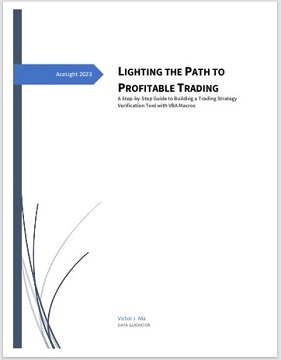Stock Trading Exit Strategies: Maximizing Profits and Minimizing Risks
|
|
Welcome to our brief guide on stock trading exit strategies. Picture this:
You're sitting at your computer, sipping your favorite caffeinated beverage,
watching stock charts with intense focus, when suddenly a squirrel pops up
on your screen, wearing a miniature suit and holding a sign that says, "Exit
Now." Okay, maybe that's a bit far-fetched, but hey, we can dream, right?
In this blog post, we will delve into various exit strategies that can
help you optimize your profits, manage risks, and make informed decisions in
the dynamic world of stock trading. So, squirrel or no squirrel, let's jump
right in!
Table of Contents:
1. Importance of Stock Trading
Exit Strategies
Successful stock trading involves not only
identifying profitable entry points but also having a well-defined exit
strategy. Exit strategies provide traders with a systematic approach to
manage risk, lock in profits, and protect their trading capital. Without a
clear exit plan, emotions can cloud judgment, leading to impulsive decisions
or missed opportunities.
An effective exit strategy is essential for
several reasons:
a. Preserving Capital: Exit strategies safeguard
against significant losses and prevent a single trade from draining your
trading account.
b. Profit Maximization: A well-executed exit
strategy allows you to capture and secure profits at optimal levels,
ensuring you don't miss out on potential gains.
c. Risk Management:
Exit strategies help limit downside risks by setting predefined exit points
based on specific criteria, such as stop loss orders.
d. Discipline
and Emotional Control: A systematic exit strategy helps traders remain
disciplined and avoid making hasty decisions based on fear or greed.
2. Common Stock Trading Exit Strategies
Let's explore some of the
most commonly used stock trading exit strategies that can be employed to
enhance your trading performance:
a. Stop Loss Orders: Stop loss
orders are one of the fundamental tools in risk management. A stop loss
order is placed at a predetermined price level, and it automatically
triggers a sell order when the stock price reaches or falls below that
level. This strategy helps limit potential losses by providing an exit point
when the trade moves against your expectations.
b. Trailing Stop
Orders: Trailing stop orders are dynamic stop loss orders that trail the
stock price at a specified distance. As the stock price increases, the
trailing stop order adjusts accordingly, always maintaining a set distance
from the highest price reached. This allows traders to protect profits by
capturing gains while still providing room for the stock to move in their
favor.
c. Take Profit Orders: Take profit orders are used to secure
profits by setting a target price at which you want to exit a trade. When
the stock price reaches or surpasses the specified level, a sell order is
automatically triggered. This strategy allows traders to lock in gains and
avoid potential reversals.
d. Time-Based Exits: Time-based exits
involve setting a predefined duration for a trade. Regardless of the stock's
performance, a trader exits the position after a certain period. This
strategy is particularly useful for short-term traders or when trading
volatile stocks.
e. Price-Based Exits: Price-based exits rely on
technical analysis indicators and patterns to determine when to exit a
trade. Traders may use support and resistance levels, moving averages, or
other indicators to identify potential exit points based on price movements.
f. Trend Reversal Exits: Trend reversal exits involve exiting a trade
when the stock's price action indicates a possible trend reversal. Traders
monitor patterns such as a break in trendlines, a change in momentum
indicators, or the formation of chart patterns to identify potential trend
reversals and exit accordingly.
g. Volatility-Based Exits:
Volatility-based exits are suited for traders who prefer to capture
short-term price swings in highly volatile stocks. By setting exit points
based on the stock's volatility, such as a percentage move or standard
deviation, traders can exit positions during periods of excessive price
fluctuations.
3. Combining Exit Strategies for Optimal Results
While each exit strategy mentioned above has its merits, it's important
to note that there is no one-size-fits-all approach. Traders often combine
multiple exit strategies to create a robust and personalized plan that
aligns with their trading style and risk tolerance.
For instance, a
trader might use a trailing stop order to protect profits and a take profit
order to lock in gains at a predefined target price. Alternatively, a
combination of price-based exits and trend reversal exits can help capture
profits during trending markets while providing protection against potential
reversals.
By combining different exit strategies, traders can adapt to
changing market conditions, maximize profits, and manage risks effectively.
4. Exit Strategy Examples: Real-World Scenarios
To illustrate
how exit strategies work in practice, let's consider a few real-world
scenarios:
a. Scenario 1: Using a Trailing Stop Order Suppose you
enter a long position in a stock at $50 per share. To protect against
downside risk, you set a trailing stop order at 5% below the stock's highest
price. As the stock price rises to $60, the trailing stop order adjusts to
$57, maintaining a 5% trailing distance. If the stock then starts to decline
and reaches $57, the trailing stop order triggers a sell order, locking in a
14% gain from the initial entry point.
b. Scenario 2: Implementing a
Take Profit Order In this scenario, you enter a short-term trade and set a
take profit order at $70. If the stock price reaches or exceeds $70, a sell
order is executed, realizing a profit. This exit strategy ensures that you
capture gains at a predetermined target without being influenced by
short-term market fluctuations.
c. Scenario 3: Applying a Time-Based
Exit Let's say you are trading a highly volatile stock and decide to use a
time-based exit strategy. You enter a position and set a time-based exit of
three days. Regardless of the stock's performance, if three days have
elapsed, you exit the trade. This approach helps avoid being exposed to
excessive volatility or unexpected news events.
5. Risk Management
and Exit Strategies
Risk management is a crucial aspect of
successful stock trading, and exit strategies play a pivotal role in
controlling risks. By setting stop loss orders, trailing stop orders, or
predetermined exit points, traders can limit potential losses and protect
their capital.
It's important to determine the appropriate
risk-reward ratio for each trade and adjust exit strategies accordingly. For
example, a trader may choose a wider stop loss for a swing trade to allow
for greater price fluctuations, while a shorter-term trade may require a
tighter stop loss to protect against quick reversals.
Regularly
monitoring and adjusting stop loss levels as the trade progresses can also
help protect profits and adjust to changing market conditions. Traders
should also consider diversifying their portfolio and avoiding overexposure
to any single stock or sector to mitigate risks.
6. Reviewing and
Adjusting Exit Strategies
Exit strategies should be continuously
evaluated and refined to reflect a trader's evolving trading style, market
conditions, and risk tolerance. Regularly reviewing and backtesting exit
strategies can provide valuable insights into their effectiveness and
identify areas for improvement. Traders should also stay updated on market
trends, news events, and economic indicators that could impact their
positions and adjust their exit strategies accordingly.
 Remember, as with all things in life, there are no
guarantees. For any trading strategy, no
matter how good it sounds, we must test it before using it in the real
market. These tests include back-testing and forward-testing. Without proper
testing, trading will turn into guesswork or even worse, gambling. Here is a tutorial handbook discussing trading
strategies and verification tools, and best of all, it’s absolutely free!
LIGHTING THE PATH TO PROFITABLE TRADING: A Step-by-Step Guide to Building a
Trading Strategy Verification Tool with VBA Macros Remember, as with all things in life, there are no
guarantees. For any trading strategy, no
matter how good it sounds, we must test it before using it in the real
market. These tests include back-testing and forward-testing. Without proper
testing, trading will turn into guesswork or even worse, gambling. Here is a tutorial handbook discussing trading
strategies and verification tools, and best of all, it’s absolutely free!
LIGHTING THE PATH TO PROFITABLE TRADING: A Step-by-Step Guide to Building a
Trading Strategy Verification Tool with VBA Macros
And click Free Trial to download strategies testing tools, all for a 30-day Free Trial.
Click on Subscription to order more strategies testing tools to help your stock trading.
7. Conclusion
Mastering stock trading exit strategies is
essential for traders aiming to achieve consistent profitability and manage
risks effectively. By employing a combination of stop loss orders, trailing
stop orders, take profit orders, and other exit strategies, traders can
enhance their decision-making process and optimize their trading results.
Remember, practice, discipline, and continuous learning are key to success
in stock trading.
Remember, while we may not have squirrels in suits
helping us with our trades (yet), mastering these strategies is no laughing
matter. So, go forth, trade wisely, and may your profits be as big as a
squirrel's stash of acorns! Happy trading!
|


|

Free Tutorial
Share
|
|
|
|